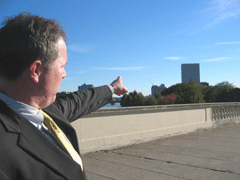Development's Carbon Cost
Air Date: Week of October 19, 2007

Chris Gordon is overseeing the new Allston development for Harvard University. (Photo: Ashley Ahearn)
Some states and local governments are calling on developers to calculate the climate impact of their development projects. As Living on Earth’s Ashley Ahearn reports, measuring the greenhouse gas emissions from the loss of trees or new construction may be the first step to limiting the emissions.
Transcript
CURWOOD: Converting land to new housing or commercial buildings can aggravate global warming. How much depends on what you measure. There are the emissions from heating and cooling of course, but some people also count the loss of trees, or even new, longer commutes. Now some states and local governments are starting to pressure developers to calculate the climate impact of their projects. At the head of the pack is Massachusetts. Living on Earth’s Ashley Ahearn has our story, and she begins with a look at a major expansion at Harvard University.
AHEARN: Chris Gordon is standing on a bridge over the Charles River. He’s pointing across the water to where Harvard University’s about to break ground on a new 200-acre development that will include academic buildings, housing, and community centers.
GORDON: On the right you can see the beginning of the Allston campus, which is primarily the business school now, and then beyond that is where the rest of the new Allston campus will be developed.
AHEARN: Gordon is chief operating officer for the new development. All of the buildings will adhere to top green building standards—solar panels, geothermal heat from the earth, energy efficiency. But one—the new science center—is taking the concept further.
After being approached by the state government, Harvard agreed the science center would take the building industry standard for emissions, and cut that in half.

Chris Gordon is overseeing the new Allston development for Harvard University. (Photo: Ashley Ahearn)
GORDON: Fear (laughs). No, I mean the debate was of course—can you do it? I mean we wanted to do it and we felt we could but we really wanted to do our homework to make sure we could do it.
AHEARN: Managers of all large developments in Massachusetts will be facing similar challenges under a new state policy. Ian Bowles is the secretary of Energy and Environmental Affairs for the commonwealth.
BOWLES: What we did this year was we included for the first time, greenhouse gases in the types of things we’re going to require people to analyze.
AHEARN: Bowles says the new policy asks developers to ask themselves a few questions:
BOWLES: What impacts are you going to have? How much are your emissions going to be, and what are the steps you could take to avoid, minimize or mitigate the damage you may do to the environment?
AHEARN: Major state projects, like the Big Dig for example, will have to go further. They’ll have to account for what are called the lifecycle emissions of the project. These are the emissions from construction, operation of the structure, and transportation to and from the site once it’s up.
That might seem like a pretty comprehensive assessment—and in the urban world, it is. But Dan Sosland, head of the nonprofit Environment Northeast, says that if you head to the wilder parts of the country, the greenhouse gas picture isn’t complete without factoring in how the landscape will be changed.
SOSLAND: If we don’t pay attention to the loss of forests, the steps that we’re taking to reduce emissions in other areas are going to be neutralized, in effect, by increased emissions from these developments.
AHEARN: The Plum Creek Timber Company, the largest private landholder in the country, has plans for an over 20,000-acre development along Moosehead Lake in Maine’s north woods. Sosland and Environment Northeast decided to assess the greenhouse gas emissions of the proposed development and produced a report.

Dan Sosland is the head of Environment Northeast
(Courtesy of Environment Northeast)
AHEARN: Luke Muzzy is a spokesperson for Plum Creek Timber.
MUZZY: This has never been discussed before as part of the permitting process. I don’t believe it has been in any development in the state of Maine. Global warming is a serious concern for everybody. I mean it is for me personally, but I also realize that areas like mine have got to grow and there is going to be development.
AHEARN: Other builders and developers are just beginning to address this trend. The National Association of Home Builders says it's studying the issue.
Judi Greenwald, a policy analyst at the Pew Center on Global Climate Change, says the carbon cost of development is beginning to register with policymakers around the country.

Building standards, state by state.
(Courtesy of Pew Center on Global Climate Change)
GREENWALD: As we’re all starting to sit up and pay attention to how to reduce greenhouse gas emissions people are using whatever tools they can find.
AHEARN: In California, Attorney General Jerry Brown ignited a firestorm this summer, when he tried to force local governments to count greenhouse gases when they make growth decisions that are going to create new longer commutes. Republicans in the legislature were so angry it led to a budget stalemate for two months.
King County, Washington has added greenhouse gas pollution to its project review and the state of Washington plans to follow suit. The District of Columbia also plans to require developers to calculate greenhouse gas emissions.
GREENWALD: This is another example of states and localities filling this federal vacuum that we have, and they’re also playing an interesting role as laboratories, which they often do on a lot of policy arenas in the United States.
AHEARN: Lab rats or not, the sudden attention to climate change is inspiring ideas that would have seemed far fetched just a few years ago. Counting tons of CO2 from developments, some say, could be the first step towards limiting them.
For Living on Earth, I’m Ashley Ahearn.
[MUSIC: Daniel Lanois “O’Marie” from ‘Acadie’ (Daniellanois.com—2005)]
Links
Environment Northeast's Assessment of the Plum Creek Development in Maine's North Woods
The Pew Center on Global Climate Change tracks regional and state activity on greenhouse gases
Living on Earth wants to hear from you!
Living on Earth
62 Calef Highway, Suite 212
Lee, NH 03861
Telephone: 617-287-4121
E-mail: comments@loe.org
Newsletter [Click here]
Donate to Living on Earth!
Living on Earth is an independent media program and relies entirely on contributions from listeners and institutions supporting public service. Please donate now to preserve an independent environmental voice.
NewsletterLiving on Earth offers a weekly delivery of the show's rundown to your mailbox. Sign up for our newsletter today!
 Sailors For The Sea: Be the change you want to sea.
Sailors For The Sea: Be the change you want to sea.
 The Grantham Foundation for the Protection of the Environment: Committed to protecting and improving the health of the global environment.
The Grantham Foundation for the Protection of the Environment: Committed to protecting and improving the health of the global environment.
 Contribute to Living on Earth and receive, as our gift to you, an archival print of one of Mark Seth Lender's extraordinary wildlife photographs. Follow the link to see Mark's current collection of photographs.
Contribute to Living on Earth and receive, as our gift to you, an archival print of one of Mark Seth Lender's extraordinary wildlife photographs. Follow the link to see Mark's current collection of photographs.
 Buy a signed copy of Mark Seth Lender's book Smeagull the Seagull & support Living on Earth
Buy a signed copy of Mark Seth Lender's book Smeagull the Seagull & support Living on Earth

